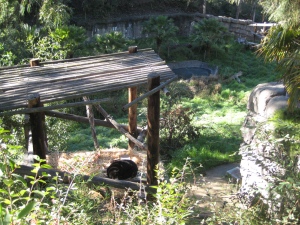 Ting explores Halloween enrichment. No, that is
Ting explores Halloween enrichment. No, that is
not a real giant candy corn. Zoo guests and especially young students often ask us how we get our animals, imagining myself or a zoo keeper running after zebras in the savanna sun with nets and ropes. Of course, this is quite illegal these days and I would never work for an institution that did such things. Accredited zoos acquire animals through a variety of means, from purchasing an individual from another zoo, to breeding them on-site, to rescuing an animal in need of a home or even finding a hedgehog in a Tupperware dish outside the door to your office (yes, this happened).
If I were to take you on a tour of our animals with a focus on where they came from, you would be amazed. Our tigers came from a circus, our juvenile lions from an illegal situation in Texas, our rabbits from a humane society, our pot bellied pigs from a family discarding a pet. Each tells a story of animal welfare or conservation – and it is this aspect of the Oakland Zoo that I am most proud of. In many ways, we are a sanctuary.
 Ting naps in straw atop her tree house,
Ting naps in straw atop her tree house,
her huge, green and peaceful enclosure
in background. One of the most telling stories is that of Ting Ting, our Sun Bear from Borneo. Ting had not had an easy life. She was captured by poachers as a cub in her native country of Malaysia on the island of Borneo. They likely killed her mother to sell parts of her body on the black market and captured the young cub to sell as a pet. If so, she likely spent the first few years of her life in various homes, alone, in small enclosures and without appropriate food and care. Eventually Ting was confiscated by government officials when she was approximately three years old. She was put into an over crowded rescue facility where she spent the next six years. Like many wild animals, once in captivity, Ting had lost her natural fear of people and had not developed the necessary skills a bear needs to survive. Ting was too dangerous and ill-prepared to return to the wild. Due to the stress of these poor captive environments Ting developed stereotypic (abnormal repetitive behavior) pacing. This behavior develops to alleviate stress but typically continues as a habit even when the stress is gone.
In 1996 and again in 2000, the Association of Zoos and Aquariums coordinated two importations for a total of 20 Malaysian Sun Bears of the Bornean subspecies to help relieve the over crowded conditions of the rescue facility and to maintain our captive population. Ting Ting was sent to the San Diego Zoo in 2000 where she lived for six years, before she came to her home with us at the Oakland Zoo at the end of 2006. We plan on seeing her through to the end of her life, giving her tree houses to nap in, enrichment to play with, honey to eat, a pool to catch fish in, room to roam in her giant enclosure and eventually, a friend. It has been a long journey for Ting and we are glad she is home for good. We hope her story inspires guests to find out more about Sunbears and explore other conservation issues, as well as look at the role of zoos with fresh eyes.
To hear more about the plight of Sunbears and biodiversity in all of Borneo, please join us for a lecture on December 12th with Cynthia Ong and Heather Pierson of LEAP (www.leapspiral.org). Check www.oaklandzoo.org for details.
